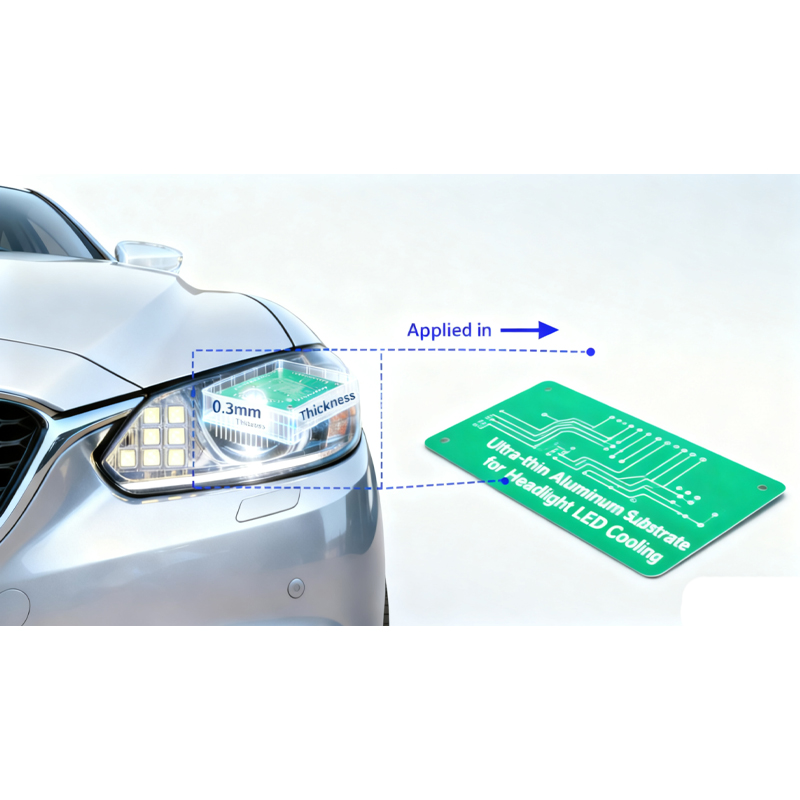Date: 2025-11-11
Buying the right aluminum substrate for demanding applications like electric vehicle controllers or 5G equipment is trickier than it looks. Many get burned by focusing only on price or falling for spec sheets with impressive-looking but meaningless numbers. Here’s a straightforward guide to navigating the procurement process, avoiding common traps, and getting a board that actually works.
1. Thermal Performance: Cutting Through the Hype
The numbers on a data sheet can be misleading. Here’s what to really focus on.
Thermal Conductivity (λ): The Whole Story Matters
Don't just look at the aluminum core's rating (which is always high). The real bottleneck is the dielectric insulation layer. A supplier might boast about their aluminum, but if the insulation layer is poor, the board will overheat.
Key Question: Ask specifically for the thermal conductivity of the insulation layer. For high-power apps, you need ≥5 W/(m·K). Materials like ceramic-filled epoxy or graphene composites hit this mark.
Watch Out For: Vague terms like "high thermal conductivity" without a number or a defined test standard (like ASTM D5470).
Total Thermal Resistance (Rθja): The Number That Actually Counts
This is the most important metric. It measures the board's overall ability to get heat from the component down to the base.
Demand a Test Report: Require suppliers to provide a total thermal resistance value for the full stack-up (copper + dielectric + aluminum). A good 0.5mm board should achieve a total Rθja below 2.5°C/W.
Real-World Check: Ask if they can provide thermal imaging from a test under a load similar to your application.
Thermal Expansion (CTE): The Silent Killer
If the board expands and contracts at a different rate than your components during heat cycles, solder joints will crack. Look for boards with a matched CTE (around 15-18 ppm/°C).
2. Vetting Your Supplier: Beyond the Brochure
A supplier's true capability is more than a list of certifications.
Non-Negotiable Certifications:
Safety: UL94 V-0 for flame retardancy.
Quality: ISO 9001 is the bare minimum.
Automotive: IATF 16949 is mandatory for anything going into a vehicle.
High-Reliability: IPC-A-600 Class 3 for medical, military, or aerospace.
Probing Their Real Capability:
Ask for Evidence: "Show me your process control data." Look for a CPK value of 1.33 or higher, which proves they can manufacture consistently.
Ask About Testing: Do they do thermal shock cycling? Can they show you the results? A reputable supplier will have this data on hand.
Evaluate Their Engineering Support: The best suppliers act as partners. Can they help with thermal simulations? Will they provide a reference design? If they just take an order and disappear, look elsewhere.

3. Understanding the Real Cost: It's More Than the Price Tag
The cheapest board per square meter often becomes the most expensive one in the long run.
Where the Money Goes:
The raw materials (aluminum, dielectric, copper) make up most of the cost. Premium materials like specialized fillers or ultra-thin cores come at a premium, but they often enable savings elsewhere.
The Hidden Costs That Kill Your Budget:
Assembly & Rework: A poorly performing board leads to higher assembly yields and field failures.
System Cost: A better board might cost 10% more but allow you to use a smaller, cheaper heat sink or a less powerful fan, saving you money overall.
Reliability: A board that causes your LED lights to dim 30% faster or your motor controller to fail in the field will destroy your product's reputation and generate massive warranty costs.
4. Smart Procurement Tactics
Tier Your Suppliers:
Have one or two primary "strategic partners" for most of your volume. Then, qualify one or two smaller, regional suppliers as backups to keep your primary suppliers competitive and to handle unexpected demand spikes.
Protect Yourself from Price Swings:
The prices of copper and aluminum fluctuate. Discuss long-term pricing agreements with your suppliers to stabilize your costs.
Get a Warranty:
A supplier confident in their quality will stand behind it. Negotiate a quality guarantee or a performance warranty into your contract.
5. Quick Application Guide
| Your Product | What You Need | What to Ask For |
|---|---|---|
| EV Motor Controller | Handles high heat & power surges | Dielectric conductivity ≥5 W/m·K, IATF 16949 certified |
| 5G Base Station | Stable performance across temperatures | Low dielectric loss (Df<0.003), proven -40°C to +85°C reliability |
| Industrial Drive | Tough, reliable under vibration | Total thermal resistance ≤1.0°C/W, high peel strength |
| LED Lighting | Good performance, low cost | Dielectric conductivity ≥2 W/m·K, 50,000+ hour lifespan data |
Red Flags During Procurement
Vague Specs: "High thermal conductivity" with no number or test method.
Missing Certificates: No IATF 16949 for auto, or no RoHS/REACH for exports.
No Test Data: Unwilling or unable to provide thermal resistance measurements.
Too Good to Be True Pricing: The cheapest option is almost always the most expensive mistake.
The Bottom Line
Buying aluminum substrates is an engineering decision, not just a purchasing task. Focus on the total thermal performance, partner with suppliers who can prove their quality and expertise, and evaluate cost based on the total system impact, not just the unit price. Doing this homework upfront saves immense time, money, and frustration down the road.
Capel manufacturing PCBs since 2009. Professional technology and high-precision Printed Circuit Boards involved in Medical, IOT, UAV, Aviation, Automotive, Aerospace, Industrial Control, Artificial Intelligence, Consumer Electronics etc..